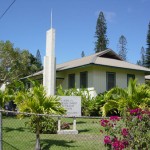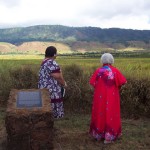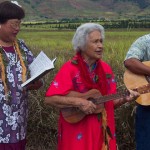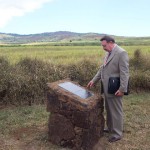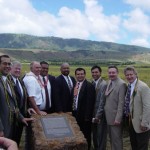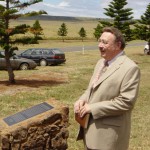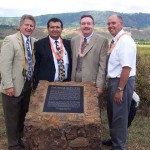Sesquicentennial Commemoration, Palawai Basin, Lana'i, Hawaii (2004)

Photo courtesy: Fred Woods
On October 3, 2004, a historic marker celebrating the sesquicentennial establishment of the City of Joseph was dedicated. The marker is in the Palawai Basin in Hawaii, the first official gathering place for Hawaiian Latter-day Saints in the Pacific. On October 3, 1854, Ephraim Green, a missionary for The Church of Jesus Christ of Latter-day Saints, began laying out a community for the gathering of Church members in Hawaii. Green wrote, “I took my compass and commenced to lay out a town . . . at the foot of the mountain and laid out one street running south to the sea three miles to a fine little harbor.”
The colony became home to about 300 Hawaiian Latter-day Saints.
The Church eventually located another spot in La’ie on O’ahu to move to. The monument, located three miles south of the city Lana’i, is a tribute to the faith and dedication of the early Hawaiian Saints.
The Mormon Historic Sites Foundation and the Mormon Pacific Historical Society provided funding for this historic marker.
The plaque reads as follows:
PALAWAI PIONEERS
Located one mile north of here at the foot of the mountain between Wai’apa’a Gulch and Palikoa’e Gulch in the ahupua’a of Palawai lies the site of the Mormon community known as the “city of Joseph” in the “valley of Ephraim.” On 3 October 1854, Ephraim Green, a missionary for The Church of Jesus Christ of Latter-day Saints, commenced laying out a community for the gathering of Church members in Hawaii on land leased from Chief Levi Ha’alelea. Green wrote, “I took my compass and commenced to lay out a town . . . at the foot of the mountain and laid out one street running south to the sea three miles to a fine little harbor.” This colony became home to about 300 Hawaiian Latter-day Saints learning and living a “practical religion” in the midst of their homes, gardens, a church and a school.
Due to difficult conditions, three years later at the October 1857 mission conference, the decision was made to begin searching for a new gathering place. The land passed into the hands of Walter Murray Gibson, who made it his ranch. The Church eventually located another gathering spot in La’ie on O’ahu. However, the seeds planted here in Palawai in the hearts and minds of the people were later harvested in La’ie.
Mormon Historic Sites Foundation
Mormon Pacific Historical Society
October 3, 2004
Photos
Articles & Resources
Gathering Place of Mormons on Lanai Recognized, The Maui News
Author(s):
Published in: The Maui News
Publication Date: October 9, 2004
LANAI CITY. Mention Laie, Oahu, and many people’s first thoughts will turn to the Church of Jesus Christ of Latter-day Saints. But a century and half ago, the focus would have been on the Palawai ahupuaa on Lanai because it was Hawaii’s first major gathering place for the islands’ Mormons.
On Sunday, church members gathered to dedicate a marker on Castle & Cooke land off the road between Manele Bay and Lanai City. The marker commemorates the sesquicentennial of the establishment in 1854 of the City of Joseph, which had been a temporary gathering place for church members.
The dedication of the marker was conducted by Arnold K. Wunder, president of the Kahului Hawaii Stake of the Church of Jesus Christ of Latter-day Saints.
The temporary gathering place was part of a concept developed by the church because of intense persecution in America and elsewhere during the 19th century. At these sites, Mormons would gather before traveling to the church¹s headquarters in Utah, as converts were expected to do.
The first Mormon missionaries arrived in Hawaii in December 1850. In 1854, membership was more than 3,000, and Palawai was chosen as a temporary gathering place. That October, missionary Ephraim Green began to lay out a plans for the the fertile land, with the goal of establishing a self-sustaining agricultural community.
The land between the Waiapaa and Pulikoae gulches was owned Hawaiian Chief Levi HaŒalelea, who agreed to let the church use it on an experimental basis for four or five years, after which it would be leased at $175 per year.
The site became home to 300 people, who built homes, a church and school. Difficulties in shipping their products to markets in Lahaina and on other islands, along with those encountered in most agricultural endeavors, led the Mormons to look elsewhere for a gathering place, said Carl Van Zweden, a church member from Lahaina.
As it says on the historic marker, The seeds planted here in Palawai in the hearts and minds of the people were harvested in Laie.
The Oahu town is home to Brigham Young University-Hawaii and the Polynesian Cultural Center, both continuing the self-sustaining community concept.
The concept of the temporary gathering place was replaced in the early 1900s with the idea that strong, permanent communities should be developed where church members lived, Van Zweden said.
Sunday’s dedication also included a historical presentation about the Hawaiian Latter-day Saints of the period 1850-61 by Fred E. Woods, executive director of the Mormon Historic Society, and Aunty Genoa Keawe singing “Hawaii Aloha.”
Also participating in the dedication were Ronald K. Hawkins, Honolulu Mission president; Riley Moffat, president of the Mormon Pacific Historical Society; and Kim Wilson, chairman of the Mormon Historic Sites Foundation.
Lanai legacy not forgotten
Author(s): Julie Dockstader Heaps
Published in: LDS Church News
Publication Date: October 16, 2004
LANAI CITY, HAWAII.
The original gathering place for the Hawaiian saints was memorialized Oct. 3 with a stone maker commemorating the settling of the Palawai basin here 150 years ago. The dedication of the monument, a stone pier of volcanic rock with an anodized aluminum plaque, was a culmination of three days in which the sacrifices of early Hawaiian pioneers on the island of Lanai were remembered with song, dance, words, and prayers.
“It was a wonderful opportunity for us to commemorate the sacrifices of our Hawaiian pioneers,” Kahului Hawaii Stake President Arnold K. Wunder told the Church News.
President Wunder, whose stake includes the Hawaiian islands of Maui, Molokai, and Lanai, was among several speakers at the Sunday afternoon event and offered the dedicatory prayer on the monument with some 60 others looking on. The dedication was conducted by Lanai Branch President Oscar T. Aguilar and presided over by President Wunder. Other speakers included Hawaii Honolulu Mission President Ronald K. Hawkins; Fred E. Woods, executive director of the Mormon Historic Sites Foundation; Kim R. Wilson, chairman of the Mormon Historic Sites Foundation; and Riley Moffat, president of the Mormon Pacific Historical Society.
The dedication of the monument which was funded by the Mormon Historic Sites Foundation and by the Mormon Pacific Historical Society, was on the third day of events commemorating the sesquicentennial of the founding of the City of Joseph on Lanai in 1854. Members watching broadcast sessions of general conference at the Lanai Branch meetinghouse attended the dedication after the end of the last session.
On Friday, Oct. 1, more than 200, including some non-LDS friends and neighbors, attended a culture night at the local public school. Among Hawaiian songs and dances was a performance by well-known Hawaiian musician Genoa Keawe, who also let those at the dedication in singing “Come, Come, Ye Saints,” accompanying on the ukulele. On Saturday evening, Oct. 2, Brother Woods, who is also a BYU professor of Church History and Doctrine, gave a lecture on the history of the Church on Lanai.
In his Sunday remarks, President Wunder compared the sacrifices of the early Hawaiian saints with those of pioneers on the mainland called to gather in Ohio, Missouri, Illinois, and, finally, Utah. The first LDS baptisms, he said, occurred at the the Pulehu chapel on Maui, from where many were called to settle a colony in the Palawai Basin on Lanai.
“They left their homes like [the pioneers] on the mainland to answer the call to gather,” he related. “It is my hope that the memorial [on Lanai] will remind our members of the sacrifices that the early saints were asked to make and were willing to make.
“In my talk [at the dedication], I challenged Lanai Branch members to use that monument as a focal point to remind themselves of those sacrifices and to view themselves as modern-day pioneers. I told them that a pioneer is someone who goes ahead to prepare the way for others. Those 45 active members are pioneers in their own way, and they are there to prepare the way for others.”
President Aguilar told the Church News: “The members of the Lanai Branch as well as of our stake have a great appreciation of what this monument stands for. The monument brings to light the sacrifice and obedience of early pioneers who obeyed the call of establishing ‘Iosepa,’ a gathering place for the saints of the Hawaiian islands. It celebrates the legacy of dedicated Hawaiian saints who committed their lives to our Savior.
“A knowledge of their great struggles, hopes and accomplishments helps us recognize how the hand of God is continually touching and blessing this land, and gives modern pioneer saints faith to continue the job and duty of expanding the kingdom of God.”
In his address, Brother Wilson reminded the gathering that the Lana’i experience was similar to trials the Mormon pioneers faced in Missouri and on Zion’s Camp, and noted that Lanai was a training ground for these faithful Hawaiian saints. He bore a testimony of Doctrine and Covenants 58:2-7, emphasizing the words from verse 4 that “after much tribulation come the blessings.”
The first Latter-day Saint missionaries arrived in the Hawaiian islands in 1850. By 1854 Church membership had reached more than 3,000 and the Palawai Basin on Lanai was chosen by the Church as a temporary gathering place for Hawaiian members. These early pioneers faced many hardships, including crop failures, flea and broken farm equipment. They struggled to cultivate farms with little water.
It is recorded that in September 1854, they transported a load of cattle from Lahaina on the island of Maui to Lanai using three whale boats. Elder Francis Hammond wrote: “Notwithstanding all the evil predictions of the wicked and unbelievers, many of whom said before we started that we would never reach Lanai,…I paid no attention to this, for I knew that God was with us. After the cattle were all landed…we all knelt down together and returned our heartfelt thanks to God for his preservations and care.”
The Lanai Meetinghouse
Photo courtesy Jace McQuivey, Hawaii Reserves, Inc.
In 1861, a self-appointed leader, Walter Murray Gibson, usurped Church leadership and took over Church organization and property. He was subsequently excommunicated but the Church was defrauded of its property on Lanai. Thus, in 1865, 6,600 acres were purchased on the north shore of Oahu. Today, in Laie, there is a temple, along with the Polynesian Cultural Center and BYU-Hawaii.
Some of those speaking at the monument dedication on Lanai said that while many view the colony on Lanai as a failure, the seeds of faith planted in the minds and hearts of the early Palawai pioneers were later harvested at Laie.

